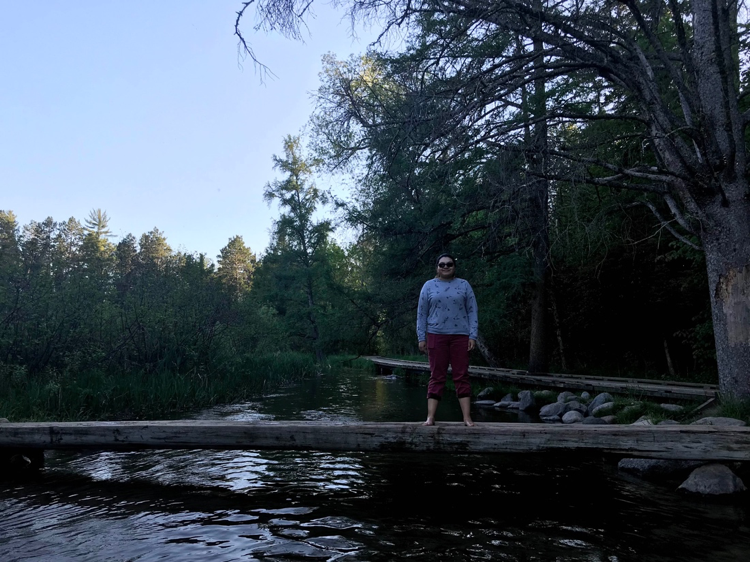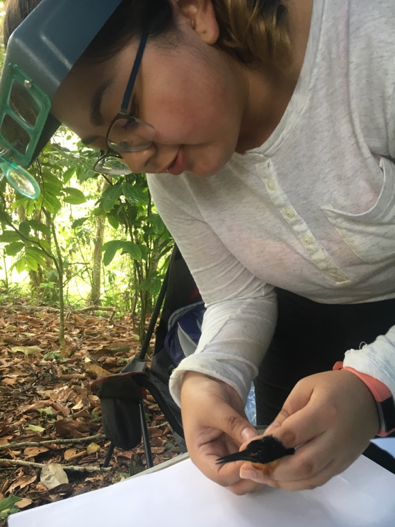[This blog was written by Stephany Virrueta-Herrera, a PhD student in the Johnson lab at the Illinois Natural History Survey. It is part of the SIB Student Research Experience, a blog series that offers a closer look at our students and their research.]

During undergrad, I took an ornithology course and became interested in studying both birds and conservation, which led me to the PEEC program at Illinois, where I am now starting my third year as a PhD student. In February 2017, I visited the Johnson lab at Illinois, where Kevin Johnson (now my PhD advisor) introduced me to bird lice. Birds are hosts for several different types of parasites, lice being one of them. There are several types of bird lice, which vary based on what part of the bird’s body they live.
My research explores the evolutionary patterns of the lice found on several different types of birds, with some of my specific projects including birds that live in the Neotropics. At the moment, I am wrapping up a manuscript in which I used whole genome data from lice of an ancient linage of birds, tinamous, to estimate their evolutionary origins (ancestry) in relation to other bird lice.
While they are one of the most abundant organisms on the planet, there is still a lot about parasites that we don’t know. There is even less information about parasites in non-temperate climates. Bird lice in particular can help us understand many different things because they live outside their host, but spend their entire lives on the same host. They are also very small, which makes their genome relatively easy to sequence.
As lice spend all, if not most, of their lives on the same hosts, many times there are similarities between host and parasite evolutionary trees. Lice are not limited to humans or birds, and in a recent study I worked on, we found that seals and their lice have coevolved. An interesting finding from this study showed that seal lice with the highest genetic diversity corresponded with seal hosts with the most individuals. We would need further data to confirm these findings, but this case illustrates that parasites can provide information on what’s happening with the host population, as the lice with the lowest genetic diversity corresponded to an endangered seal.
Being a grad student entails a lot of research and working behind a computer in my office, but recently I have been able to go on some cool travels for work. I attended the 2019 Midwest Phylogenetics Workshop at the University of Minnesota’s Itasca Biological Station. During the workshop, I not only gained new skills and knowledge in comparative phylogenetics (methods that allow us to study the history of how organisms evolved and diversified), but also had the opportunity to meet and work with colleagues thinking about similar phylogenetic questions across the country.

Conferences are also a wonderful opportunity to present work and meet with colleagues from around the world. I also recently traveled to Alaska for the American Ornithological Society’s 137th meeting, where I presented my work on tinamou lice, met colleagues and collaborators, and also experienced some of Alaska’s unique habitats.

Being a part of an interdisciplinary department in SIB means that my peers and I study a wide diversity of organisms and systems. Over spring break, I had the opportunity to work with fellow PEEC student, Kira Long, in Panama. Kira studies manakins, but in her work, she also catches several other neotropical birds which also happen to land in her nets. While Kira processed birds for her ongoing studies, I was able to collect feather lice from some of the birds.
Spending time with the birds in their actual habitat was a wonderful experience, and it was truly amazing to be able to see live lice crawling through their hosts’ feathers trying to avoid being removed, in this case, by me.

After being at Illinois for two years, there are still many questions that remain unanswered, and that is one of my favorite parts about being a scientist. Lice are parasites on their hosts, but we also know that most lice are also hosting symbiotic bacteria. Feather lice on birds specifically are thought to host these bacteria because they can help provide nutrients which are limited in their feather-based diets (Smith et al. 2013).
I am currently working with an IB undergrad, Lorenzo D’Alessio, on a project exploring the symbionts found in tinamou lice. So far, we have found evidence for bacteria such as Sodalis (and other genera), which may not be previously described in lice, for which we hope to have more solid results and prepare a manuscript for in the near future. This study will allow us to further knowledge of host parasite systems, and eventually make connections and comparisons from bird (host) to lice (parasite/host) to bacterial symbiont.
